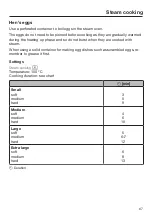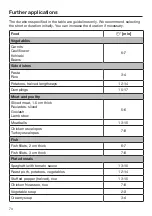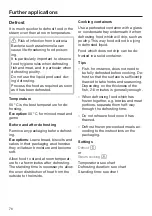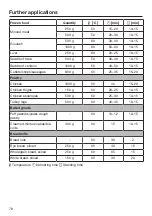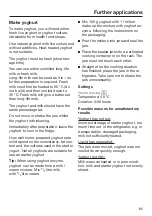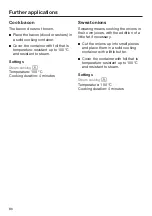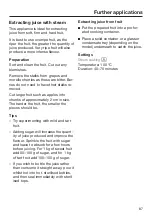
Further applications
76
Defrost
It is much quicker to defrost food in the
steam oven than at room temperature.
Risk of infection from bacteria.
Bacteria such as salmonella can
cause life-threatening food poison-
ing.
It is particularly important to observe
food hygiene rules when defrosting
fish and meat, and in particular when
defrosting poultry.
Do not use the liquid produced dur-
ing defrosting.
Process the food as required as soon
as it has been defrosted.
Temperature
60 °C is the best temperature for de-
frosting.
Exception:
50 °C for minced meat and
game
Before and after defrosting
Remove any packaging before defrost-
ing.
Exceptions
: Leave bread, biscuits and
cakes in their packaging as otherwise
they will absorb moisture and become
soft.
Allow food to stand at room temperat-
ure for a few minutes after defrosting.
The standing time is necessary to allow
the even distribution of heat from the
outside to the inside.
Cooking containers
Use a perforated container with a glass
or condensate tray underneath it when
defrosting food which will drip, such as
poultry. This way food will not be lying
in defrosted liquid.
Food which does not drip can be de-
frosted in a solid container.
Tips
– Fish, for instance, does not need to
be fully defrosted before cooking. De-
frost so that the surface is sufficiently
thawed to take herbs and seasoning.
Depending on the thickness of the
fish, 2–5 minutes is generally enough.
– When defrosting food which has
frozen together, e.g. berries and meat
portions, separate them half-way
through the defrosting time.
– Do not refreeze food once it has
thawed.
– Defrost frozen pre-cooked meals ac-
cording to the instructions on the
packaging.
Settings
Defrost
or
Steam cooking
Temperature: see chart
Defrosting duration: see chart
Standing time: see chart






